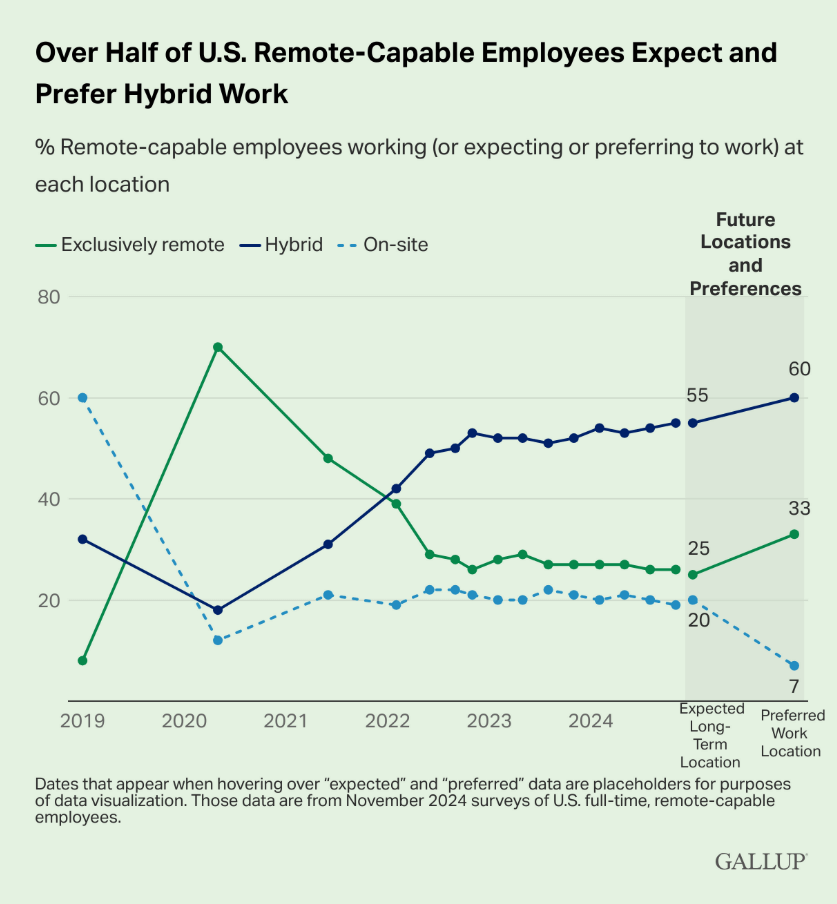Remote work today isn’t like in the early days of lockdown, when few relevant tools were available and there were few means of tracking what employees did. Today, building a robust remote workforce and managing it effectively can be very easy.
Of course, adopting a fully remote or hybrid approach for your business can present challenges. But simply being prepared can help you navigate those challenges and take advantage of the opportunities of remote work in 2025.
The Power of Remote Working in Numbers
With the rise of automation software, such as sales automation software, your workforce can do more in less time. The best part is that these tools are entirely digital.
If it’s a cloud-based application, your workers can access the software and datasets they need from absolutely anywhere.
In short, it’s entirely possible for every company that uses digital tools like AI, automation, or management software to offer remote work because your staff can access those tools from anywhere. Not every role can be remote, but those that can be should be.
Remote work is also increasing. In 2020, when remote workers rose meteorically, only around 20% of the world’s population worked remotely. By 2023, the number of remote workers had increased to 28% of the global workforce.
When it comes to remote working, productivity isn’t an issue. While there may be a learning curve as workers discover how to stay productive at home, the numbers speak for themselves.
In a study conducted by Great Place to Work with more than 800,000 participants, it was found that workers were equally, or even more, productive at home.
Five of the Biggest 2025 Remote Work Trends

There are several remote work trends that business owners and managers need to be aware of in 2025.
-
The Increase of AI-powered Remote Work
AI and machine learning are changing how we work and what we can do with our data. We can use the large datasets collected and put them to use, providing customers with better quality services and products at a lower cost.
AI can also support, manage, and even hire employees more effectively. Using AI for recruiting, for example, can speed up the application screening process and provide a better candidate experience for every applicant, allowing your business to efficiently and successfully revamp your hiring process locally and internationally.
This is just one example. AI is a digital product that can be easily adopted by your remote and hybrid workers. AI is able to complete more basic administrative tasks, giving employees more time for creative problem-solving and helping to reduce the working-from-home (WFH) burnout rate.
-
Top Talent Will Demand Hybrid or Remote Work Opportunities
People want to work remotely. Commuting is draining and adds hours of dead time to a person’s day. With the cost of housing and rent skyrocketing — especially in city centers — commutes are only getting longer.
It’s no wonder that a Gallup survey found that out of remote-capable workers, 55% now work in a hybrid setting, 26% in a fully remote setting, and just 19% in the office.
Notably, only 7% of respondents claimed their preferred work location was in the office full time, while 60% would prefer a hybrid work model.
-
Globalization: New Roles Worldwide
The best-paying remote jobs in 2025 may not be in your home country. With remote work, more talented people can secure roles in international businesses without leaving home.
The remote-working model also means that companies can access top talent without needing to sponsor employees to relocate.
There are still local laws and regulations to comply with, but the ability to globalize the workforce has led to new possibilities for businesses worldwide.

Image sourced from Gallup
-
The Increase of Freelancing
Freelancing is also set to be a growing trend among remote workers in 2025. In 2023, 73.3 million Americans worked as freelancers, and this number is expected to increase to 79.6 million in 2025 and 90.1 million by 2028.
Europe tells a similar story.
-
By the end of 2025, 43 million people in the EU are expected to work freelance.
-
According to a study by Malt, 61% of freelancers questioned stated they had no interest in changing to a full-time role.
Freelancing also has potential for businesses, especially if demand is uneven during certain seasons. Hire extra freelancers before the Christmas rush or outsource your marketing needs to help cover a new, one-off event.
-
Hybrid Work Approach
Fully remote isn’t your only option. One of the most prominent remote work trends in 2025 is the hybrid model, where employees are working in the office for a few days a week and working from home the rest of the week.
How often they’re in the office varies from case to case. Some businesses offer a two-day home and three-day office split. Others only request that their staff come in once a week or once a month.
5 of the Biggest Challenges Facing Remote Teams in 2025

There are a few challenges that businesses need to be aware of before launching a remote or hybrid program. Let’s take a look at five of them.
-
Managing Teams Across Time Zones
Managing remote teams can be done locally, nationally, or even internationally. Adding a global talent base to your roster can mean gaining key insights into new markets, which can be invaluable for your business. However, managing those employees remotely can be a challenge.
You’ll need to train your managers to manage a remote team and adjust to an asynchronous work style to accommodate workers in entirely different time zones whose working hours differ from those in your head office.
-
Technical Limitations
Remote work is inherently limited by the technical limits of an employee’s home environment. If their internet speed is slow, they won’t be able to work efficiently on high-demand projects. The same applies to at-home computers and other devices.
While some of the limits can be solved by providing work computers, for example, certain elements will need to be upgraded by the employee before hybrid or remote working is allowed.
-
Security Hitches and Threats
Security risks are another factor, especially since attempts and breaches are rising. For example, unauthorized access (hacking) attempts in the UK increased from 522,000 in 2019 to 883,000 in 2024.
HBR states that over 80% of breaches occur due to human error.
For these reasons, some businesses don’t allow remote work (for example, those that work with highly sensitive information). Before you jump on that bandwagon, however, know it’s entirely possible to secure a network of remote employees through:
-
Using endpoint protection
-
Training
-
Restricting user access
-
Using secure channels
Securing a remote team for most businesses is entirely doable; it’s just slightly more complicated.
-
Increased Employee Burnout

Another challenge with remote work is the phenomenon of increased burnout. The use of digital communication tools led to 69% of remote workers reporting that they felt burned out.
Remote working burnout can also happen due to improper management, where managers assume remote employees can do more than they can simply because the manager cannot physically see the work that goes into each task.
Other causes of digital burnout can include:
-
Excessive workloads
-
Micromanagement
-
Unrealistic expectations
-
Little to no reward for hard work
-
Little to no support
-
Little to no flexibility
-
Monitoring Performance and Productivity
One of the major concerns for businesses is how they’ll be able to monitor the performance and productivity of their remote employees if they don’t have an eye on them.
The good news is that plenty of performance, productivity, and workflow management solutions are available to help managers do exactly that.
Managers only need to change from expecting immediate updates to checking in now and again on how an employee is doing while working on a project with a tighter deadline.
Five Big Opportunities for Remote Work in 2025
Remote work is the biggest perk of 2025. Workers want to score a remote job or at least a hybrid one. Adding either option to your roster is how you can provide a highly coveted perk to your employees and, in turn, attract top talent, retain them, and enjoy these opportunities:
-
A diverse, international talent force that can help you effectively break into new markets
-
Access to a larger pool of talent beyond your local area
-
Happy employees who can better manage their personal life with their work, increasing retention and loyalty
-
The chance to decrease your office size and save big on rent
-
The ability to help your employees’ salaries go further by reducing or eliminating commuting costs from their daily spending
Tools and Approaches Needed to Make Remote Work More Effective

You’ll need a few tools and standards to take advantage of the benefits of remote working in 2025.
Automated, Cloud-Based Solutions
First, you need cloud-based AI or automated solutions that work to decrease admin and improve results. If you can’t connect to said solution over the cloud, look for solutions that allow all your employees to use it regardless of their location.
For example, investing in a lead-generation tool that remote employees can use can help you better connect with international opportunities.
If you have a global workforce that works remotely and everyone has access to the same tools, they can use those lead generation tools to connect with local leads and make a pitch.
There are many lead generator solutions, including the up-and-coming ZoomInfo alternative that offers more robust options at lower rates.
There are many options, including using top competitors or an up-and-coming ZoomInfo alternative that’s either more robust, more economical, or both.
You’ll also want task and time management software so that you can either assign tasks to employees or see who’s working on what, when, and how long it’s taking them.
With the time tracking tool, you’ll need to wait to generate an average of how long each action takes across multiple employees. This way, you can identify which tasks people are struggling with and which tasks simply need more time or resources.
A Unified but Digital Presence
When you manage a remote team, you have people working across the city, country, or world. Despite this global presence, it’s imperative that you, as a company, look and feel singular.
A good way to do this is to use simple tools like a digital phone number, a single address (or a virtual address), and established TOV guidelines for whenever anyone on your payroll interacts with customers, clients, or the press.
Expanded Digital Security and Training
Before allowing remote work, you’ll need to establish a security framework. This can include buying certified and secure work devices for your employees to use when they work from home. If you’re using a custom virtual environment, make sure you have ways to make regular backups - either manually, or with solutions like agentless Proxmox backup.
You can also use AI to track your team’s movements and build a digital footprint of what’s expected so that it can notify your security teams when it detects an unusual activity. Even something as simple as limiting user access is a good place to start.
De-Sync: Adopt an Asynchronous Approach Toward Management

One of the best things you can do for your workforce is to deviate from the mindset that workers should be available 24/7. Instead, switch to an asynchronous management approach that focuses on setting individual task deadlines.
This approach works brilliantly with remote settings since it allows at-home workers more flexibility while keeping to their deadlines. If you need something done by the next day's start, don’t worry about when the worker does it. All that matters is that it gets done on time.
Retrain or Upskill Employees to Better Use Automated Software
Fully remote employees don’t have the same access to hands-on training or support as their in-office or hybrid co-workers. This means they may be less adept at using your team's tools, especially if you’ve recently swapped to new software.
That’s why it’s in your best interest to create or rely on pre-made training programs every time you introduce a new solution to your business.
Take your sales team, for example. Having a remote sales team can make you more agile and able to respond and capture leads internationally or at least nationally. If your remote sales team isn’t fully retrained or upskilled to use the tools you use, however, you may not see the same results.
That’s why, after choosing the best sales software, you must invest in in-depth training for your in-house and remote teams. As long as the training program is digital first (videos, interactive elements, etc.), all employees can use it.
Top Takeaways

Remote work is in demand by most employees, even if it’s only on a hybrid or part-time basis. Adding remote work to your perks list is an excellent way to draw in top local and international talent.
There are a few challenges to adopting a remote or hybrid approach, but with the right tools and know-how, you can take advantage of the big opportunities that remote work has to offer in 2025.






